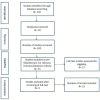Person-Centered Care From a Relational Ethics Perspective for the Delivery of High Quality and Safe Healthcare: A Scoping Review
- PMID: 32211362
- PMCID: PMC7067745
- DOI: 10.3389/fpubh.2020.00044
Person-Centered Care From a Relational Ethics Perspective for the Delivery of High Quality and Safe Healthcare: A Scoping Review
Abstract
Background: The aim of this scoping review is to explore whether or not person-centered care (PCC), in its quest to deliver high quality and safe health care, has a relational-ethics perspective. To do so, we first need to relate the extant literature pertaining to PCC and relational ethics. To this extent, the specific features that define PCC and relational ethics were identified. PCC dimensions include: patient and provider concordance, improved health outcomes, improved patient safety, individual expectations, patients' integration within the environment, patient as a person, patient as an active part of society, dialogue and interaction, sharing experience, and documentation of patient's (person's) narrative. Relational ethics framework includes the following actions: mutual respect, engagement, embodied knowledge, environment, and uncertainty. Methods: Data were retrieved through multiple keywords search on PubMed, Medline, and Scopus. Inclusion/exclusion criteria were set, and these were based on year of publication (2008-2018), language, paper focus, research method and document types. A total of 23 articles (N = 23) were selected and reviewed. Content analysis was conducted in order to identify and compare the main features of PCC and relational ethics. Results: The most important relational ethics action referred to in conjunction with PCC features is environment (referred to as person's integration within a social environment/community). This is followed by mutual respect, engagement and embodied knowledge. These were the salient relational ethics actions both directly and indirectly linked to PCC. Uncertainty was the less recurrent relational ethical action mentioned. Conclusions: This paper revealed that while PCC features embrace most of the relational ethics approaches, these are not exploited in their entirety and therefore PCC emerges as a unique ethical stance in healthcare. PCC's ethical approach goes beyond what is explained within provider-patient relational ethics and emphasizes that the patient is an active person and a partner in care with capabilities and resources. This distinction enables us to explain the paradigm shift from "patient-centered" to "person-centered" care. The healthcare provider partnership and co-creation of the healthcare plan contributes to the delivery of high quality, safe and cost-contained healthcare.
Keywords: ethics; health systems; patient safety; patient-centered care; person-centered care (PCC); quality of care; relational ethics.
Copyright © 2020 Tomaselli, Buttigieg, Rosano, Cassar and Grima.
Figures
References
-
- Institute of Medicine. Crossing the Quality Chasm: A New Health System for 21st Century. Washington, DC: National Academy Press; (2001). - PubMed
Publication types
MeSH terms
LinkOut - more resources
Full Text Sources



